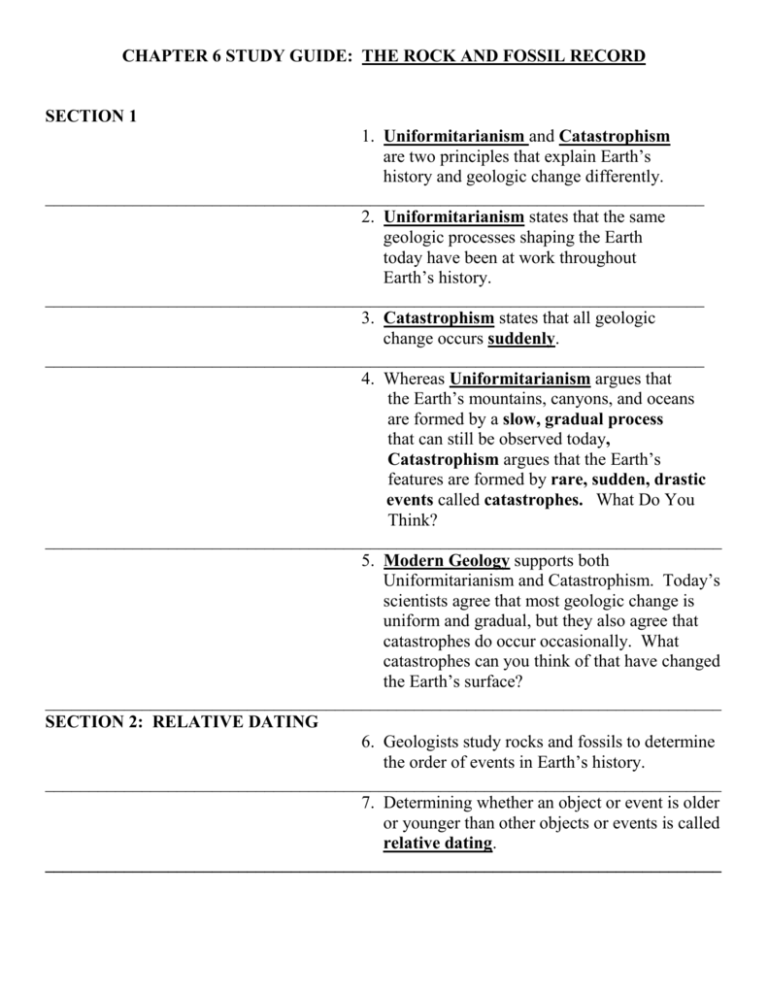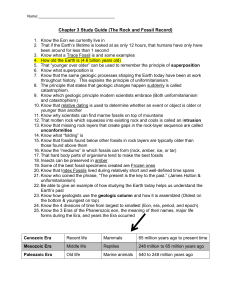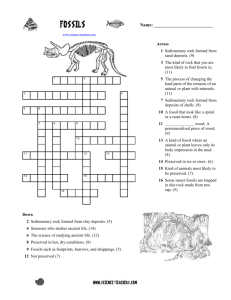CHAPTER 6 STUDY GUIDE: THE ROCK AND FOSSIL RECORD
advertisement

CHAPTER 6 STUDY GUIDE: THE ROCK AND FOSSIL RECORD SECTION 1 1. Uniformitarianism and Catastrophism are two principles that explain Earth’s history and geologic change differently. ___________________________________________________________________________ 2. Uniformitarianism states that the same geologic processes shaping the Earth today have been at work throughout Earth’s history. ___________________________________________________________________________ 3. Catastrophism states that all geologic change occurs suddenly. ___________________________________________________________________________ 4. Whereas Uniformitarianism argues that the Earth’s mountains, canyons, and oceans are formed by a slow, gradual process that can still be observed today, Catastrophism argues that the Earth’s features are formed by rare, sudden, drastic events called catastrophes. What Do You Think? _____________________________________________________________________________ 5. Modern Geology supports both Uniformitarianism and Catastrophism. Today’s scientists agree that most geologic change is uniform and gradual, but they also agree that catastrophes do occur occasionally. What catastrophes can you think of that have changed the Earth’s surface? _____________________________________________________________________________ SECTION 2: RELATIVE DATING 6. Geologists study rocks and fossils to determine the order of events in Earth’s history. _____________________________________________________________________________ 7. Determining whether an object or event is older or younger than other objects or events is called relative dating. _____________________________________________________________________________ 8. Superposition is a principle that states that younger rocks lie above older rocks in undisturbed sequences. “YOUNGER OVER OLDER” is a phrase you can use to remember this principle. _____________________________________________________________________________ 9. The geologic column is an ideal sequence of rock layers that contains all the known fossils and rock formations on Earth arranged from oldest to youngest. Geologists rely on the geologic column to interpret rock sequences. _____________________________________________________________________________ 10. Sometimes rock layers are disturbed by features and events. Features that can disturb rock layers are faults and intrusions. Events that can disturb rock layers are folding and tilting. _____________________________________________________________________________ 11. Faults and intrusions are features that cut across rock layers. A fault and intrusion ARE ALWAYS YOUNGER THAN THE LAYERS THEY CUT ACROSS. _____________________________________________________________________________ 12. Folding and tilting are events that disturb the horizontal layers of rock. Folding and tilting ARE ALWAYS YOUNGER THAT THE ROCK LAYERS THEY AFFECT. _____________________________________________________________________________ 13. An uncomformity is a surface that represents a missing part of the geologic column. _____________________________________________________________________________ 14. Unconformities form where rock layers are missing and they create a gap in the rock-layer sequences. _____________________________________________________________________________ 15. Unconformities are created by nondeposition of sediments and/or erosion of sediments. _____________________________________________________________________________ 16. There are three types of unconformities: disconformity, nonconformity, and angular unconformity. They each represent missing time - time that was not recorded in layers of rock. _____________________________________________________________________________ 17. A disconformity exits where part of a sequence of parallel rock layers is missing. A disconformity is the most common type of unconformity and the most difficult to see. _____________________________________________________________________________ 18. A nonconformity exists where sedimentary rock layers lie on top of an eroded surface of non-layered igneous or metamorphic rock. _____________________________________________________________________________ 19. An angular unconformity exists between horizontal rock layers and rock layers that are tilted or folded. (The tilted or folded layers were eroded before horizontal layers formed above them.) _____________________________________________________________________________ SECTION 3: ABSOLUTE DATING 20. Absolute Dating is the process of establishing the age of an object, such as a fossil or rock layer, by determining the number of years it has existed. How does this differ from relative dating? _____________________________________________________________________________ 21. Isotopes are atoms of the same element that have the same number of protons but have different numbers of neutrons. _____________________________________________________________________________ 22. Unstable isotopes are radioactive. _____________________________________________________________________________ 23. Radioactive isotopes tend to break down into stable isotopes of other elements in a process called radioactive decay. _____________________________________________________________________________ 24. If you know the rate of decay for an element in a rock, you can figure out the age of the rock. Determining the absolute age of a sample based on the ratio of parent material to daughter material is called radiometric dating. _____________________________________________________________________________ 25. The time it takes for one-half of a radioactive sample to decay is called a half-life. _____________________________________________________________________________ 26. There are three types of radiometric dating: (1) Uranium-Lead Method, (2) PotassiumArgon Method, (3) Carbon-14 Method. _____________________________________________________________________________ 27. Scientist use different radiometric dating techniques based on the estimated age of an object. For example: Uranium-238 has a halflife of 4.5 billion years, so it can be used to date rocks more than 10 million years old. However, Carbon-14 has a half-life of only 5,730 years, so it is mainly used for dating things that lived within the last 50,000 years. Potassium-40 has half-life of 1.3 billion years, so it dates rocks older than 100,000 years. _____________________________________________________________________________ SECTION 4: FOSSILS 28. A fossil is any naturally preserved evidence of life. _____________________________________________________________________________ 29. Usually fossils are preserved in rock when the soft, fleshy parts of their bodies decay and the hard parts are quickly buried in sediment. However, fossils may be preserved in other ways. Read on to discover other ways fossils are preserved. _____________________________________________________________________________ 30. Fossils may be preserved through mineral replacement, such as permineralization and petrification. Permineralization occurs when minerals fill in the pore spaces of an organism’s tissues. Petrification occurs when the organism’s tissues are completely replaced by minerals. _____________________________________________________________________________ 31. Many insect fossils, such as mosquitoes, are preserved in amber, which is hardened tree sap. Some organisms are preserved through mummification, which occurs when the body of the organism dries out before it can decay. Other fossils may preserved in tar pits and in ice. Some of the best fossils are frozen specimens. _____________________________________________________________________________ 32. A trace fossil is any naturally preserved evidence of an animal’s activity. Examples include tracks, burrows, and coprolites. _____________________________________________________________________________ 33. Coprolites are preserved feces or dung from animals. Coprolites provide valuable information about the habits and diets of the animals that left them. _____________________________________________________________________________ 34. Molds and Casts are also considered fossils. A mold is a cavity in the ground or rock where a plant or animal was buried. A cast forms when sediment fills a mold and becomes a rock. A cast shows what the outside of the organism looked like. _____________________________________________________________________________ 35. By examining fossils scientists can find out what was happening in the environment when the sediments surrounding the fossils were deposited. For example, What do fossils of marine organisms on the top of a mountain tell us? _____________________________________________________________________________ 36. Scientists can interpret how plants and animals have changed over time by studying fossils from different parts of the geologic column. For example, we know that fish existed before amphibians because fish were found in a lower layer of rock. How do we know that amphibians existed before reptiles? _____________________________________________________________________________ 37. Index fossils are fossils that lived during a relatively short period of time. Index fossils help scientists date a rock layer without directly using radiometric dating. _____________________________________________________________________________ SECTION FIVE: GEOLOGIC TIME SCALE 38. The geologic time scale, divides the Earth’s 4.6 billion year history into distinct intervals of time. _____________________________________________________________________________ 39. The largest divisions of geologic time are the eons. Eons are divided into eras. Eras are divided into periods. Periods are divided into epochs. Epochs are the shortest divisions of geologic time. 40. The Paleozoic Era: Paleozoic means “old life.” The first land-dwellers – plants and amphibians were evident during this era. _____________________________________________________________________________ 41. The Mesozoic Era: Mesozoic means “middle life.” This era is known as the Age of Reptiles. Dinosaurs inhabited the land and water. _____________________________________________________________________________ 42. The Cenozoic Era: Cenozoic means “recent life.” The Cenozoic Era began 65 million years ago and continues to the present. This era is known as the Age of Mammals. Which era do we live in? _____________________________________________________________________________ 43. Scientist estimate the Earth to be 4.6 billion years old. If the Earth’s history is put on a scale of only 12 hours, human civilization would have been around for less than one second. _____________________________________________________________________________







